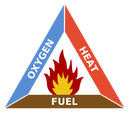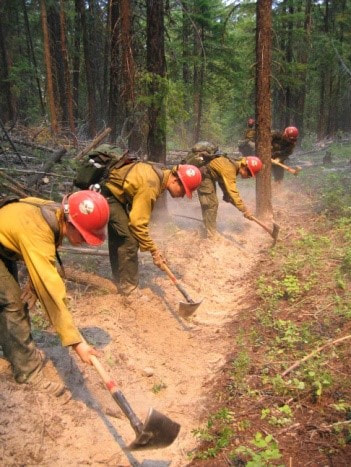 The Fire Triangle is made up of oxygen, heat, and fuel. Without all three of these, there is no fire. That seems like an easy concept to get across to the public, right? The problem is that most people only have experience with fires where oxygen (throw dirt on it) or heat (throw water on it) breaks the triangle. From campfires to major structure fires seen on the TV news or in movies, oxygen and heat get starring roles while fuel is rarely considered unless it is literally an accelerant like gasoline or a tossed kerosene lamp. On a wildfire, we deal almost exclusively with fuel, by which we mean vegetation. If a wildland fire gets going, the heat will be too strong to just pour water on it and we can’t do anything about the atmosphere which has, you know, oxygen. Our only option is to take the fuel away from the fire.  We do this by getting out ahead of the fire and building a fireline, fortifying a road, working from a ridgetop, establishing a control line along a riparian area, or punching in dozer line. From those, we will burnout the vegetation between our line and the main fire. This can be difficult for people to conceptualize and we will often receive criticism for “not putting the fire out” as if we could walk up to the front of a 15,000 acre fire and squirt it with water. When I was on the Rodeo-Chedeski Fire, I took a call from a guy who wondered why we couldn't just line the fire with the 1,500 people assigned and have everyone walk towards the middle putting out the fire as they went. Another frustrated caller wanted us to drop those "boxes of water" (cubies) on the fire to put it out. For comparison’s sake, a typical suburban acre has 4/8/16 single family homes on it surrounded by well-manicured and watered yards with streets and driveways. The typical forested acre (acre= about a football field with the endzones) that will fuel a wildfire could have enough vegetation on it to equal 60-80 or more homes. When you add wind, slope, and aspect plus the fact that it is rarely just one acre but tens or hundreds or thousands, we simply can’t use the same suppression techniques that we use for the more familiar structure fires. We have to take the fuel away. And we have to clearly explain what that means. Which brings me to terms, a frequent blog theme here. Burnout is not only a more accurate term, it is the best term to use for the vast majority of wildfire situations. Words have formal definitions and then they have personal interpretations, emotional connections, and connotations. In some glossaries, backfire carries the same definition as burnout, yet backfire is a word of hard, fearsome consonants. It conjures backdraft and may create an image of danger and out-of-control firefighting. It can also be confused with a backing fire, which is usually a good thing or at least not a terrible thing. Backfire is a word easily sensationalized by media just through tone and thus can affect public opinion and make incident information tasks more difficult. Burnouts are what we do. We're taking fuel away and making it safer for everyone. It's a nice little burnout. It's not a risky BACK-FIRE! None of this is to imply that PIOs are not honest deliverers of information. If conditions make it tough to execute a burnout, that needs to be stated. If the situation demands riskier tactics, it needs to be communicated. The critical PIO function is to convey reality as it exists, regardless of the desires of elected officials, organizational proclivities, or public wishes. Still, the PIO--and by extension, every member of the IMT and those involved in the incident--can honestly discuss what is happening without using words that might increase the complexity. Likewise, media personnel can be honest with their audiences while using appropriate terms. (I always ask reporters to use burnout.) The emergency is sensational enough to capture the public's attention--we don't need to amp it up unnecessarily with emotionally-laden words, of which backfire is one. _____ Jim Copyright © Jim Whittington, 2018, All rights reserved. Academic use approved with notification and attribution.
2 Comments
Greg R Heule
5/10/2018 10:43:40
Thanks for this Jim. The term burnout better describes what we are doing when we use fire to expand/build control lines. I hear the two terms used interchangeable so many times from our own PIOs.
Reply
JIM
5/10/2018 11:52:36
Yep. On one fire, I had a PIO who was using backfire. Had a chat with him and relayed much of what I discussed in the post. I think it made him even more excited to use backfire. It's easy for us to become addicted to the excitement and let our egos come into play when we imagine we have a monopoly on the info, allowing our adrenaline to go wild and our judgment to fade. As individuals, we need to guard against that kind of thing and as PIOs and leaders, we need to call it out when we see it.
Reply
Leave a Reply. |
Occasional thoughts on incident response, crisis communications, wildland fire, and other topics.
Docendo disco, scribendo cogito. Blog DOB: 4/26/2018Copyright © Jim Whittington, 2019. Archives
August 2019
Categories
All
|
 RSS Feed
RSS Feed